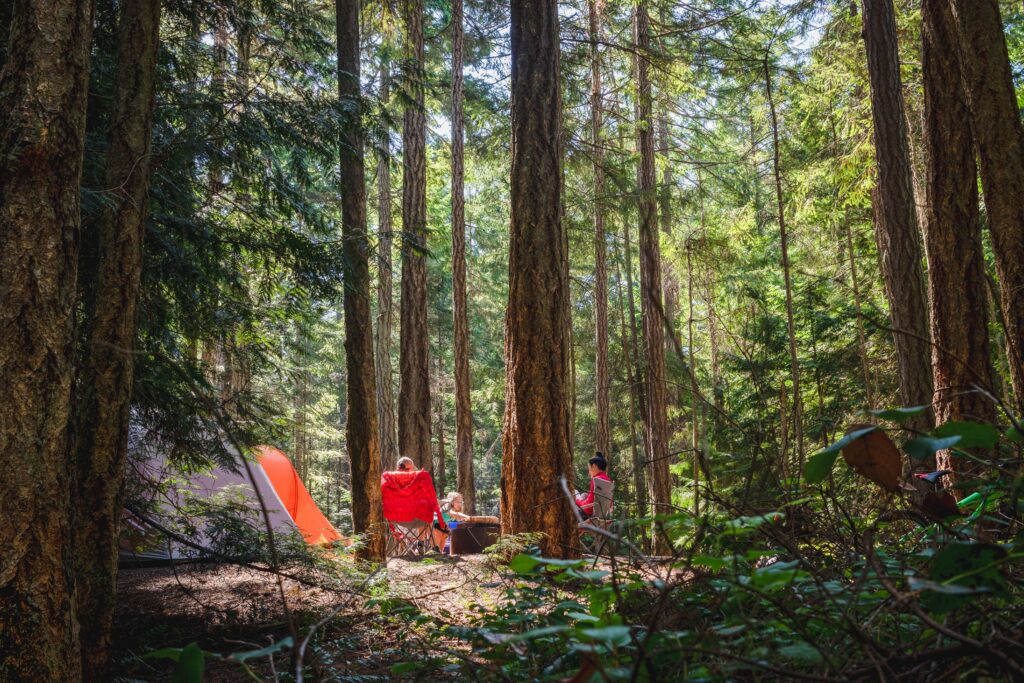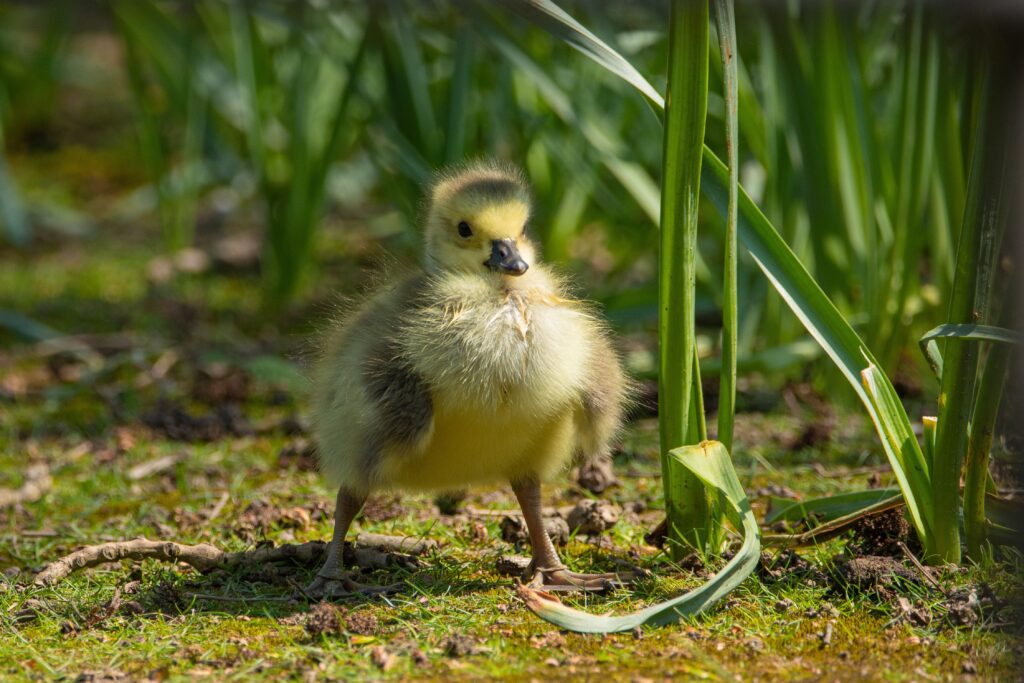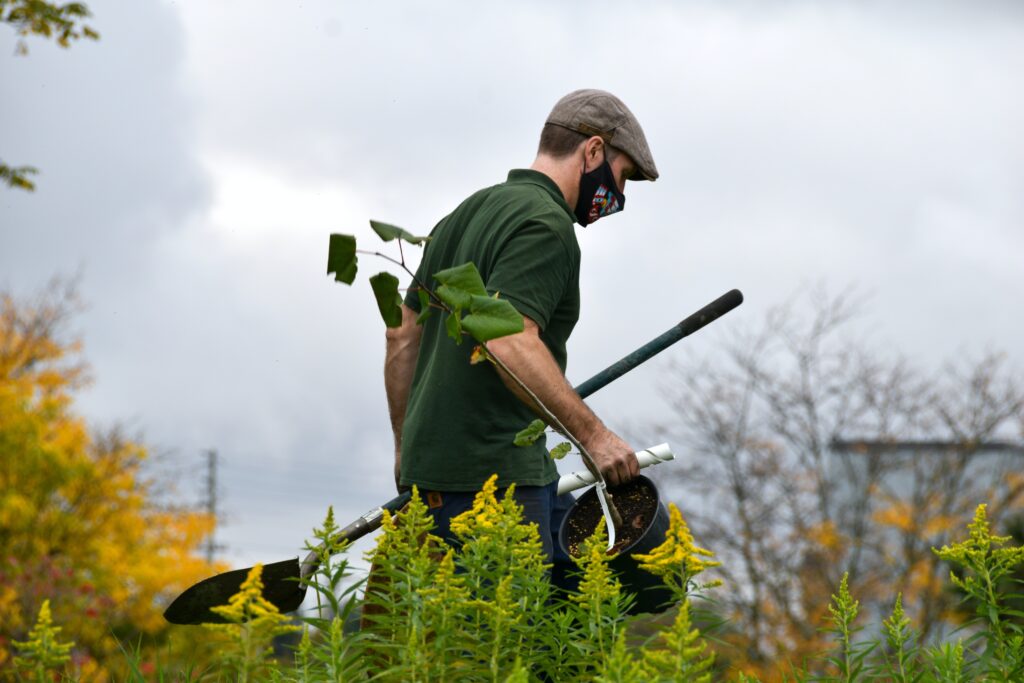Whether you’re visiting Canada on vacation this summer, or looking to explore your own backyard, Canada has an endless amount of eco-friendly travel activities to enjoy. Canada is full of natural beauty, from the Rocky Mountains in the west, to the rolling hills and stunning coastal cliffs to the east. You’d need a lifetime and a much longer list to explore everything. But as you explore and adventure through all that Canada has to offer, it’s important to remember to be mindful of the environment and the impact you leave as you go. From sustainable accommodation to farm-to-table experiences, we round up 7 eco-friendly activities to explore Canada sustainably this summer.

1. Camping, Glamping and Sustainable Accommodation
The first on our list of eco-friendly activities is one of Canada’s most popular outdoor activities – camping. According to the Worldwide Camping Index, Canada is the best place in the world to go camping. It takes the top spot for its beautiful scenery, abundance of national parks, stargazing potential, low pollution and low risk of natural disasters. Camping is one of the best ways to enjoy Canada and also happens to be one of the most eco-friendly, low-footprint, travel activities.
Parks Canada lists over 10,000 campsites across the country so you’ll be sure to find one to suit your needs. If you’re an expert camper and looking to get out into the wilderness, you can also buy backcountry camping passes from Parks Canada.
Glamping (glamourous camping) can take your camping trip up a notch, while still offering many of the eco-friendly and nature-filled benefits of camping. From wood cabins to luxury tree-houses, you don’t have to stick to a tent to enjoy some nature in Canada. Falling under sustainable accommodation, many glamping sites are also eco-friendly, including products and promoting services from the local community.
How Camping and Sustainable Accommodation Helps The Environment
Reduce Environmental Impact
Many sustainable accommodations, from camping to eco-hotels, are designed to minimize their impact on the environment. This can include waste reduction initiatives, water conservation, renewable energy use and recycling programs. These initiatives work to lower the accommodation’s overall carbon footprint and help conserve natural resources.
Promote Preservation
Camping and glamping sites are often located in or beside beautiful forests, beaches or mountains, encouraging an appreciation for nature. In fact, research shows that spending time in nature increases your pro-environmental attitudes and behaviours (PEAB).
Support Local Communities
Many glamping and sustainable accommodations source products and promote services within the local community. They also often educate visitors, providing awareness for local conservation efforts and encouraging a sustainable way of living.

2. Indigenous Craft Workshops
There’s more than 1.67 million Indigenous people in Canada, including more than 630 First Nation communities, representing over 50 Nations and languages. Indigenous peoples in Canada have been protecting and living in harmony with nature for centuries through their understanding of local ecosystems, knowledge and traditional practices.
The Indigenous Arts Collective of Canada has an amazing list of Indigenous artists that offer educational craft workshops. Showcasing Indigenous cultures and ancient art forms, these one of a kind workshops encourage a connection to your environment and Mother Earth.
How Indigenous Craft Workshops Help The Environment
Support Indigenous Communities
Indigenous peoples are the best stewards of our environment but they’ve faced numerous challenges in the last 150 years in Canada. Acknowledging these unique challenges and barriers, supporting the education and awareness of traditional practices and crafts helps to support local Indigenous communities and provide sustainable economic development.
Preserve Cultural Heritage
Workshops can contribute to the preservation of cultural heritage by teaching traditional crafting techniques that have often been passed down through generations. These workshops help preserve the knowledge of traditional techniques and practices, promoting a sense of cultural continuity.
Deepen Your Connection To Nature
Many Indigenous artists and craft workshops highlight the connection between Indigenous cultures and the natural world, emphasizing the importance of environmental stewardship and promoting respect for the environment. Participating in a workshop can help you gain a deeper understanding of Indigenous cultures and their relationship with the environment, sustainable practices and encourage a greater appreciation for the natural world.

3. Sustainable Food Tours and Farm-To-Table Experiences
Next on our list of eco-friendly activities to explore this summer are sustainable food tours and farm-to-table experience. They say one of the best ways to experience a culture is to eat its food. So maybe one of the best ways to experience Canada sustainably is through its locally-sourced, sustainable food. From coast-to-coast, Canada has plenty of sustainable food tours and farm-to-table experiences to enjoy a variety of different dishes.
How Sustainable Food Tours and Farm-To-Table Experiences Help The Environment
Reduce Carbon Footprint
Sustainable food tours and farm-to-table experiences typically focus on locally-sourced, seasonal ingredients. This lowers transportation costs and the carbon emissions that comes with transporting food long distances.
Support Sustainable Agriculture
Sustainable agriculture improves the natural environment, protects the farmers, their employees and local communities and safeguards the welfare of all farmed species. Sustainable food tours and farm-to-table experiences support sustainable agriculture by promoting small-scale farming and supporting local communities.
Reduce Food Waste
One third of food is wasted before it even gets to the kitchen table. But farm-to-table experiences often focus on reducing food waste by creatively using every part of each ingredient. This eco-friendly strategy helps reduce the amount of food going to waste, ending up in landfills and contributing to greenhouse gas emissions.

4. Birdwatching and Birding Tours
Birdwatching is popular in Canada with almost 40% of the population watching or caring for birds around their home. Canada also ranks as the 13th happiest country in the world and according to recent research, the more bird species you see the happier you are. We’re not saying birds are the reason for Canada’s high happiness levels, but we’re not not saying it. Those two facts exist. And you can do with them what you will.
Birdwatching tours are available all over the country and with 703 bird species in Canada there’s plenty to try and spot. Birdwatching might even become one of your favourite eco-friendly activities. Keep an eye out for events and festivals around the year like the Festival of Birds in Ontario, and the Wings Over The Rockies Festival in British Columbia, both in May.
How Birdwatching Helps The Environment
Increased Awareness
Birdwatching and birding tours are excellent opportunities to learn about different bird species, their habitats and the role in the ecosystem. Learning about birds can help deepen your appreciation for nature, connection to the environment and maybe even inspire conservation preservation.
Habitat Preservation
Birdwatching and birding tours can help promote natural habitat preservation. The economic benefits of sustainable tourism often help strengthen the case for continued conservation efforts and preservation of bird habitats.
Citizen Science
Birdwatching and birding tours are a great opportunity to collect some data on birds. Data collected from Citizen Scientists contributes to research and monitoring programs and can help inform conservation efforts. Birds Canada has a great list of Citizen Scientist programs across the country to explore.

5. Organic Wine Tasting And Vineyard Tours
Canada might not make the top ten list for best wine country but thanks to Ontario’s Niagara Peninsula and British Columbia’s Okanagan Valley it still makes it to the number 28 spot for global wine production. So if wine is your thing, touring some of Canada’s sustainable vineyards might be the eco-friendly activity for you this summer.
Organic and natural wine has been growing in popularity in Canada for the past few years. Organic grapes make up about 5% of all grapes in Canada and are mostly grown in British Columbia, Ontario, Quebec, and Nova Scotia. While there’s no list of organic wineries in Canada, the Organic Council of Ontario provides a list of regional resources to find organic producers and wineries.
How Organic Wine Tasting And Vineyard Tours Help The Environment
Organic Farming Practices
Organic vineyards rely on natural farming methods and avoid using synthetic pesticides, fertilizers and growth regulators. Natural farming methods include crop rotation, animal manure and mechanical cultivation.
Biodynamic farming goes a step further. Biodynamic farmers observe and work in balance with nature, treating their farm like a living system.These farmers account for the rhythms of nature, might make their own compost and observe nature to know when to do it.
Water Efficiency
Soil is king in organic farming and healthy soil holds water well, reducing the need for extensive watering in dry conditions. Organic farms have more water in their soil than conventional farms, and use natural methods to conserve water where possible. Methods like cover cropping and no-till agriculture are used to help prevent run-off and soil erosion, and rainwater is captured and reused where possible.
Increased Biodiversity
Thanks to natural farming methods and avoidance of pesticides, organic farming can increase biodiversity in an area by about 30%. For wine making, biodiversity supports vine vitality with some organic vineyards in Canada encouraging butterflies, bees, birds, small mammals and even lambs in their vineyards.

6. Forest Bathing
The next on our list of eco-friendly activities to explore in Canada is forest bathing. Developed in Japan in the 1980s, forest bathing, or shinrin-yoku, is the practice of “taking in the forest atmosphere” and is a form of eco-therapy. Research shows that spending time in nature is good for us and has positive physiological and psychological effects on our bodies. Walking around a forest can reduce stress, lower blood pressure and increase your energy levels. As a low carbon impact activity, forest-bathing is a great eco-friendly activity to enjoy this summer.
How Forest Bathing Helps The Environment
Appreciation For Nature
Spending time in nature can help you gain a deeper appreciation for the environment by exposing you to the plant and animal species around you and the value they bring to your local ecosystems. Increasing your awareness of these species can help strengthen your understanding of how to better protect and conserve their natural habitats.
Inspire Sustainable Living
Forest bathing can lead to a greater understanding of the interconnectedness of ecosystems and the impact human actions can have on the environment. This increased awareness can inspire people to make more eco-friendly choices, value natural environments and support conservation efforts.

7. Tree Planting and Reforestation Volunteering
Last on our list of eco-friendly activities to explore this summer is tree planting and reforestation volunteering. Canada is known for trees, in fact it has 30% of the world’s forests. But tree cover in Canada has decreased 11% since 2001, 50% of this loss is across British Columbia, Quebec and Saskatchewan.
Trees provide a host of environmental benefits from filtering water to absorbing carbon dioxide from the atmosphere. Not to mention, they also provide a food source and habitat for native animal species to live.
Organisations like Trees Canada and One Tree Planted provide information on how to get involved in local tree planting and reforestation programs across the country. You can volunteer individually or as part of a group as a sustainable activity this summer, or anytime time of year.
How Tree Planting And Reforestation Volunteering Helps The Environment
Water Management
Trees help with water management by absorbing, holding and filtering water. In fact, trees are made up of 50% water. They absorb falling water through their leaves, preventing run-off. Water is held in their roots helping slow down water streams and subsequent soil erosion. Without trees managing water in the environment, soil would become drier and more prone to drought and erosion during extreme flooding events.
Soil Health
In addition to helping prevent soil erosion, trees also help improve soil health. They add new organic matter through fallen leaves, moderate soil temperature by providing shade and their roots break up and aerate soil for new growth.
Carbon Sequestration
Trees can help in the fight against climate change by removing carbon dioxide (CO2) from our atmosphere. The larger the tree, the more carbon it can sequester. Canada’s managed forests alone have removed an average of 180 million tonnes of CO2e per year. Volunteering at tree planting and reforestation programs, can help increase the number of Canada’s trees and the amount of carbon captured from the atmosphere.
Sustayn is designed to present the most useful recommendations for environmentally friendly approaches and items. We update links when possible, but note that links can be broken and subject to change.









185 comments
Very neat blog. Really Cool.
hydroxychloroquine ingredients doctors for hydroxychloroquine
There’s definately a great deal to learn about this subject. I really like all the points you made.
Hello, you used to write wonderful, but the last several posts have been kinda boring… I miss your great writings. Past several posts are just a little bit out of track! come on!
Thanks for the post.Much thanks again. Want more.
Major thankies for the post.Really looking forward to read more.
Thanks again for the article post.Much thanks again. Really Great.
I appreciate you sharing this blog post. Cool.
Thank you ever so for you blog post.Thanks Again.
excellent post, very informative. I’m wondering why the other experts ofthis sector do not notice this. You must proceed your writing.I’m confident, you’ve a great readers’ base already!
I have not checked in here for a while because I thought it was getting boring, but the last few posts are great quality so I guess I¡¦ll add you back to my everyday bloglist. You deserve it my friend 🙂
Right away I am going away to do my breakfast, once having my breakfast coming yet again to read more news.
Hello are using WordPress for your blog platform? I’m new tothe blog world but I’m trying to get started and createmy own. Do you need any coding knowledge to make yourown blog? Any help would be really appreciated!
I do consider all of the ideas you’ve presented in your post.They are very convincing and can definitely work.Still, the posts are too brief for starters.May you please lengthen them a bit from subsequent time?Thank you for the post.
wow, awesome article.Really looking forward to read more. Fantastic.
generic ventolin – ventolin 90 mcg albuterol sulfate inhaler
When someone writes an paragraph he/she maintains the thought ofa user in his/her mind that how a user can be aware ofit. So that’s why this paragraph is perfect.Thanks!
There is certainly a lot to learn about this topic. I like all the points you have made.
Thanks for one’s marvelous posting! I really enjoyed reading it, you may be a great author.I will be sure to bookmark your blog and will come back very soon. I want to encourage you to continue your great posts, have a nice weekend!
Neben Polysacchariden und Triterpenen enthalten Fruchtkörper und Hut
Wonderful post but I was wanting to know if you could writea litte more on this topic? I’d be very grateful if youcould elaborate a little bit further. Thank you!
fantastic points altogether, you simply won a logo new reader. What could you suggest about your publish that you simply made a few days ago? Any certain?
I love it when folks come together and share views. Greatblog, keep it up!
Netflix’te Son Zamanlarda Ki Muhteşem 10 Dizi
provigil generic modafinil [url=]modafinil online [/url]
prix asus transformer book t100ha 2016 blanc Une Nuit En Enfer Truefrench Gratuitement tram pararam disney jungle book porn
Today, I went to the beach front with my children. I found a sea shell and gave it to my 4 year old daughter and said “You can hear the ocean if you put this to your ear.” She placed the shell to her ear and screamed. There was a hermit crab inside and it pinched her ear. She never wants to go back! LoL I know this is totally off topic but I had to tell someone!
I loved as much as you will receive carried out right here. The sketch is attractive, your authored material stylish. nonetheless, you command get bought an shakiness over that you wish be delivering the following. unwell unquestionably come further formerly again since exactly the same nearly a lot often inside case you shield this increase.
I appreciate, cause I found exactly what I was looking for. You’ve ended my four day long hunt! God Bless you man. Have a nice day. Bye
I’ve been absent for a while, but now I remember why I used to love this site. Thanks , I will try and check back more often. How frequently you update your web site?
Hello, i read your blog occasionally and i own a similar one and i was just wondering if you get a lot of spam remarks? If so how do you reduce it, any plugin or anything you can suggest? I get so much lately it’s driving me crazy so any support is very much appreciated.
Write more, thats all I have to say. Literally, it seems as though you relied on the video to make your point. You obviously know what youre talking about, why waste your intelligence on just posting videos to your site when you could be giving us something enlightening to read?
It’s actually a cool and helpful piece of information. I’m happy that you shared this helpful info with us. Please keep us up to date like this. Thanks for sharing.
Keep working ,remarkable job!
I’m very happy to read this. This is the kind of manual that needs to be given and not the random misinformation that’s at the other blogs. Appreciate your sharing this best doc.
stromectol in canada stromectol – ivermectin 1 cream
This is very fascinating, You are an overly professional blogger. I have joined your feed and stay up for in quest of extra of your excellent post. Additionally, I have shared your website in my social networks!
Hi there! I know this is kind of off topic but I was wondering if you knew where I could find a captcha plugin for my comment form? I’m using the same blog platform as yours and I’m having problems finding one? Thanks a lot!
south end apartments woodbine apartments legacy heights apartments
Hey there! Would you mind if I share your blog with my twitter group? There’s a lot of folks that I think would really appreciate your content. Please let me know. Many thanks
Sweet blog! I found it while searching on Yahoo News.Do you have any suggestions on how to get listed in Yahoo News?I’ve been trying for a while but I never seem to get there!Many thanks
When someone writes an post he/she keeps the plan of a user in his/her mindthat how a user can know it. Therefore that’s why this post is perfect.Thanks!
Say, you got a nice article post.Much thanks again. Awesome.
I need to to thank you for this good read!! I definitely loved every little bit of it. I’ve got you book-marked to look at new stuff you post…
I seriously get pleasure from your posts. Thank you
moxidectin vs ivermectin ivermectin sheep wormer
ivermectin paste tractor supply ivermectin pour on for cattle label
Im grateful for the article.Thanks Again. Really Cool.
Hello There. I found your blog using msn. This is a very well written article.I’ll be sure to bookmark it and come back to read more of your useful info.Thanks for the post. I will definitely return.
Very informative article post.Much thanks again. Great.
I blog often and I genuinely appreciate your content.Your article has really peaked my interest. I’m going to take anote of your blog and keep checking for new information about once a week.I subscribed to your Feed too.
Muchos Gracias for your blog.Thanks Again. Great.
A round of applause for your blog.Really thank you! Cool.
wow, awesome post.Really thank you! Will read on…
Hello, of course this article is truly fastidious and I have learned lot of things from it regarding blogging. thanks.
A big thank you for your blog post.Much thanks again.
You hold a specialized expertise. Your drafting proficiencies are really impressive. All the bests for posting material on the net and informing your followers.
I am no longer sure where you are getting your info, however good topic.I needs to spend some time learning more or understanding more.Thanks for fantastic info I was in search of thisinfo for my mission.
Hi there! I’m at work browsing your blog from my new iphone 4!Just wanted to say I love reading through your blog and look forward to all your posts!Keep up the great work!Also visit my blog bella-dee
Hello. excellent job. I did not expect this. This is a fantastic story. Thanks!
My family members every time say that I am wasting my time here at net, however I know I am getting familiarity daily byreading thes good articles.
I truly appreciate this post. Keep writing.
Great, thanks for sharing this blog article.Much thanks again. Much obliged.
Appreciate you sharing, great blog post. Want more.
I cannot thank you enough for the blog. Want more.
I really like and appreciate your blog. Cool.
impotence pills: ed pills that work – treatments for ed
amlodipine olmesartan norvasc medication what is norvasc]
co op apartment featherstone apartments apartments in arlington wa
Hi! Do you know if they make any plugins to help with Search Engine Optimization? I’m trying to get my blog to rankfor some targeted keywords but I’m not seeing very good success.If you know of any please share. Kudos!
You have made some really great points here. I hope numerous people are able to acquire access to this information. This is great quality of writing is deserving of attention.
Chrome-plated steel is generated by dipping common steel right into an electrolyte service consisting of chromium and also takes advantage of electrolysis to create the finishing.
Wow that was odd. I just wrote an incredibly long comment but after I clicked submit my comment didn’tappear. Grrrr… well I’m not writing all that ovcer again. Anyway, just wanted to saay great blog!
whoah this blog is magnificent i like reading your articles.Stay up the good work! You realize, a lot of individuals are hunting aroundfor this info, you can aid them greatly.
Aw, this was a very nice post. Spending some time and actual effort to generate a really good article… but what can I say… I hesitate a lot and never manage to get nearly anything done.
Really appreciate you sharing this blog article.Really thank you! Will read on…
What’s up i am kavin, its my first time to commentinganywhere, when i read this article i thought i could also make comment due tothis brilliant paragraph.
ed therapy ed medications – best ed pills online
Cómo conectar un GIF estimulante en un récord mundial
I do consider all the ideas you’ve presented for your post. They’re very convincing and will definitely work. Still, the posts are very quick for beginners. May you please extend them a little from subsequent time? Thanks for the post.
amazon ivermectinpainter atherosclerosis genetic
Hey! I just wanted to ask if you ever have any problems with hackers?My last blog (wordpress) was hacked and I ended up losing several weeks of hard work due to no back up.Do you have any solutions to stop hackers?
Howdy! Would you mind if I share your blog with my zyngagroup? There’s a lot of folks that I think would really appreciate yourcontent. Please let me know. Thank you
Link Coi Thẳng Bóng Đá Futsal Việt Nam Vs Lebanon Vòng Loại World Cupket qua seriaNếu cứ đùa như cách vừa tiêu diệt Everton cho tới 3-1 bên trên sảnh khách hàng
This is a very good tip particularly to those fresh to the blogosphere. Brief but very accurate informationÖ Many thanks for sharing this one. A must read article!
Sweet blog! I found it while browsing on Yahoo News. Do you have any suggestions on how to get listed in Yahoo News?I’ve been trying for a while but I never seem to getthere! Many thanks
Hey there! I could have sworn I’ve been to this blogbefore but after browsing through some of the post I realized it’s newto me. Anyhow, I’m definitely glad I found it and I’ll be bookmarking and checkingback often!
I don’t even know how I ended up here, but I thought this post was good. I don’t know who you are but definitely you are going to a famous blogger if you are not already 😉 Cheers!
Enjoyed every bit of your post.Really looking forward to read more.
Hey, thanks for the article post.Really looking forward to read more. Will read on…
Very good post. Awesome.
What’s Going down i’m new to this, I stumbled upon this I have discovered It positively useful and it has helped me out loads. I’m hoping to give a contribution & assist other customers like its aided me. Good job.
Τhis text is invaluable. Wherⅾe can I find outmore?Here is my blog … joker123
hello!,I like your writing very so much! share we communicate more approximately your article on AOL?I need an expert on this house to unravel my problem. Maybe that is you!Looking forward to peer you.
Medicine information. What side effects can this medication cause?can i order generic valtrex in USBest about medicament. Read here.
Greetings! Very helpful advice within this post! It’s the little changes which will make the biggest changes. Thanks for sharing!
Sign up for free, no minimum, apply today, get a free scan formula, repeat for free!!! Click now 👉🏻www.ipro369.com
Hi, this weekend is pleasant in support of me, because thisoccasion i am reading this great educational article here at my residence.
What’s up, always i used to check blog posts here in the early hours in the break of day, since i liketo learn more and more.
Asking questions are in fact pleasant thing ifyou are not understanding anything totally, except this piece of writing gives fastidious understanding even.
whoah this blog is fantastic i like studying your posts. Keep up the good work! You understand, lots of individuals are hunting round for this information, you could help them greatly.
klonopin plus tramadol what happens if i take too many klonopin can i take klonopin night before colonoscopy
Hello i am kavin, its my first occasion to commenting anywhere, when i read this post i thought icould also make comment due to this sensible post.
Some truly excellent information, Glad I observed this.
Itís difficult to find knowledgeable people in this particular subject, but you sound like you know what youíre talking about! Thanks
Im thankful for the blog article.Much thanks again. Really Cool.
A big thank you for your article.Much thanks again. Want more.
Major thankies for the post.Thanks Again. Great.
Thanks a lot for the blog. Much obliged.
Major thanks for the blog post.Really thank you! Great.
1-2-3 en Windows 10 para sincronizar y mover registro
Major thankies for the blog post. Fantastic.
Thanks a lot for the article.Really thank you! Awesome.
Hello! I’m at work browsing your blog from my new apple iphone!Just wanted to say I love reading your blog andlook forward to all your posts! Carry on the superb work!
ivermectin empty stomach ivermectin capsule
Thanks for the blog article.Thanks Again.
This paragraph provides clear idea designed for the new people of blogging, that truly how to do running a blog.
online vardenafil uk – erectylelvt generic vardenafil online pharmacy
Major thankies for the blog post.Much thanks again. Fantastic.
I don’t even know how I ended up here, but I thought this post was great. I do not know who you are but certainly you’re going to a famous blogger if you are not already 😉 Cheers!
Appreciate you sharing, great blog post.Much thanks again. Fantastic.
A round of applause for your blog article.Really looking forward to read more. Really Cool.
I cannot thank you enough for the article post.Much thanks again. Much obliged.
magnificent issues altogether, you just gained a new reader. What might you suggest about your put up that you just made a few days in the past? Any certain?
This is my first time pay a visit at here and i am genuinely pleassant to read everthing at single place.
Wow, great article.Really looking forward to read more. Awesome.
Really informative article post.Really thank you! Fantastic.
I think this is a real great blog post.Really looking forward to read more. Much obliged.
There is certainly a lot to know about this subject. I really like all of the points you have made.
Hi! I know this is somewhat off topic but I was wondering if you knew where I could get a captcha plugin for my comment form? I’m using the same blog platform as yours and I’m having problems finding one? Thanks a lot!
Wow, great article post.Really looking forward to read more. Really Cool.
Very good article post.Really thank you! Keep writing.
When I originally commented I clicked the « Notify me when new comments are added » checkbox and now each time a comment is added I get several e-mails with the same comment. Is there any way you can remove me from that service? Cheers!
It’s an awesome piece of writing designed for all the online users; they will get benefit from it I am sure.
wow, awesome blog.Much thanks again. Keep writing.
I think this is a real great article post. Keep writing.
Hey there! I just wanted to ask if you ever have any trouble with hackers? My last blog (wordpress) was hacked and I ended up losing months of hard work due to no back up. Do you have any methods to stop hackers?
There’s definately a lot to learn about this subject.I really like all of the points you have made.
A fascinating discussion is definitely worth comment. I believe that you ought to write more on this issue, it may not be a taboo matter but generally folks don’t discuss these topics. To the next! Kind regards!!
tenho navegando na internet cerca de 3horas por noite , e eu de nenhuma maneira tinha descoberto um post tão show como o seu blog.parabéns, parabenizo pelo seu dedicação na criação do seu conteúdo
Write professional school essay on founding fathers CashNetUsaUYhjhgTDkJHVy
Usually I don’t learn article on blogs, however I would like to say that this write-up very pressured me to take a look atand do so! Your writing style has been surprised me.Thanks, quite great post.
Hello! I’m at work surfing around your blog from my new iphone 3gs! Just wanted to say I love reading through your blog and look forward to all your posts! Carry on the outstanding work!
Appreciate you sharing, great article.Much thanks again. Want more.
Im grateful for the article post. Keep writing.
Muchos Gracias for your blog article. Fantastic.
It’s actually a nice and helpful piece of info.I’m glad that you just shared this helpful infowith us. Please stay us informed like this. Thanks for sharing.
Really informative article. Keep writing.
como empezar a salir con una chicaUn numero colosal de usuarios.tiene varios millones de personas registradas, de las cuales al menos la mitad son mujeres.
Why visitors still make use of to read news papers when in this technological world everything is existing on net?
I cannot thank you enough for the post.Much thanks again. Cool.
I am so grateful for your blog post.Really looking forward to read more. Awesome.
Very good post. Cool.
Hey, thanks for the post. Want more.
Thank you for the good writeup. It if truth be told used to be a leisure account it. Look complex to far added agreeable from you! By the way, how can we communicate?
I do not even know how I ended up here, but I thought this post was great.I do not know who you are but certainly yyou are going to a famous blogger if you aren’t already 😉 Cheers!
I am so grateful for your article.Really looking forward to read more. Keep writing.
Hey, thanks for the article. Keep writing.
Thanks so much for the post.Really looking forward to read more. Keep writing.
Hey, thanks for the post.Really thank you! Really Great.
I really enjoy the blog article.Much thanks again. Will read on…
I loved your blog article.Really looking forward to read more. Awesome.
A motivating discussion is worth comment. I do think that you need to publish more about this issue, it might not be a taboo matter but generally folks don’t speak about these topics. To the next! Many thanks!!
I loved your article post.Thanks Again. Keep writing.
Im thankful for the article post.Much thanks again. Awesome.
Hi there, all is going well here and ofcourse every one is sharing facts, that’s actually fine, keep up writing.
Say, you got a nice blog article.Really thank you! Want more.
This is one awesome blog.Thanks Again. Much obliged.
Really informative article post.Really thank you! Want more.
Terrific post but I was wanting to know if you could write a littemore on this subject? I’d be very grateful if you could elaborate a little bitfurther. Kudos!
I used to be recommended this blog by means of my cousin. I am no longer certain whether this put up is written through him as nobody else recognise such specific approximately my trouble. You’re incredible! Thank you!
There as definately a lot to find out about this subject. I really like all of the points you made.
Greetings! Very useful advice in this particular post! It’s the littlechanges which will make the most important changes.Thanks for sharing!Feel free to surf to my blog post :: cadets.wycombeaircadets.org
Aw, this was a very nice post. Finding the time and actual effort to generate a great articleÖ but what can I sayÖ I put things off a whole lot and never seem to get anything done.
Really informative article post.Really thank you! Fantastic.
Im obliged for the blog.Really thank you! Keep writing.
Really enjoyed this blog article.Much thanks again. Much obliged.
I know this web site gives quality based content and additional stuff, is there any other site which gives these stuff in quality?
Great, thanks for sharing this article post.Really looking forward to read more. Really Great.
Currently it seems like Drupal is the top blogging platform out there right now. (from what I’ve read) Is that what you are using on your blog?
Its fantastic as your other articles : D, appreciate it for putting up.
Hello my family member! I want to say that this article is amazing, nice written and include almost all vital infos.I’d like to look more posts like this .
I cannot thank you enough for the blog post.Really thank you! Fantastic.
You actually suggested that really well. side effects for modafinil
Awesome blog.Really thank you! Great.